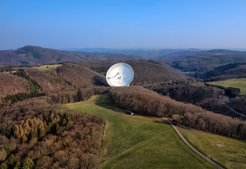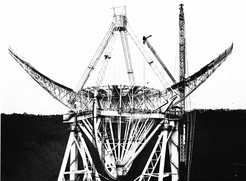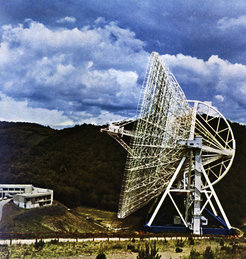History

First designs for the 100-metre radio telescope were presented by the companies Krupp and MAN, and eventually Krupp was awarded the contract. The actual building work was then carried out by the consortium “Arbeitsgemeinschaft Stahlbau-Radioteleskop”, or ARGE STAR (consortium steel construction radio telescope), which was founded especially for this purpose.
On the lookout for an appropriate location
The search for an appropriate location began several years before the construction work. There were several important points to consider:
- No proximity to larger human settlements
- No proximity to high voltage transmission lines
- No proximity to radio and television stations, if possible
It was also hoped that the location would make it possible to avoid radiation from radar transmitters, but this proved impossible. Therefore, it was decided to position the telescope in a valley where the surrounding landscape would guarantee the utmost protection from earthly signals. The valley needed to be running from North to South so that celestial objects like the centre of the Milky Way could still be observed.
One out of 30: Effelsberg
From a selection of more than 30 different locations a valley near the village of Effelsberg in the Eifel region was picked. The proximity to Bonn was one of the reasons for the decision. From a selection of more than 30 different locations a valley near the village of Effelsberg in the Eifel region was picked. The proximity to Bonn was one of the reasons for the decision. Another crucial point was the fact that the valley was so deep that even in its highest position, the primary focus of the telescope was still protected by the high hills surrounding the valley. In addition, within several kilometres the landscape features several hills which are higher than the top the telescope by at least 100 metres.
Start of construction in February 1968
The telescope is situated in a valley oriented in the North–South direction. Two creeks had to be relocated before building work was begun. In February 1968, when the site had been prepared, the foundation was laid.

The valley’s soil consists of greywacke, which is an old metamorphised sedimentary stone. This stone is solid, yet craggy. Therefore, the first measure step was to harden the soil by adding concrete. For stability reasons, the foundations had to be strongly connected to the bedrock. The base ring which carries the weight of the telescope rests on 154 concrete pillars which are between 7 and 11 metres long.
Completion in 1972

The building of the steel construction began in October 1968. The twelve parts of the primary mirror dish were built and assembled on a flattened assembly field, right next to the telescope. In December 1969, the first of the twelve parts was lifted up and positioned. April 1970 saw the lifting up of the twelfth part and thus the completion of the steel skeleton, the framework of the telescope. On August 1st, 1972, the Max Planck Institute for Radio Astronomy celebrated the launch into operation of the 100-metre radio telescope in Effelsberg.
New secondary mirror under construction
A new secondary mirror for the 100-metre radio telescope was put into operation in October 2006. An active optic system (with 100 actuators) makes it possible to correct the surface of the secondary mirror, allowing an optimal operation of the radio telescope even at millimetre wavelengths. This improvement will ensure that Germany continues to have one of the world's most flexible and most precise radio telescopes.
The full commissioning of the 100-meter radio telescope Effelsberg took place on August 1, 1972.
Since its commissioning, the telescope has been continuously adapted to the current state of technical development.
1976: Construction of the extension to the institute building
1977: Fire in the visitor pavilion, a new pavilion was built
1982: Replacement of panels in the inner area
1985: First replacement of the subreflector
1996: First replacement of the subreflector
2000: Replacement of the outer panel rings of the dish
2002: Installation of new gears for the azimuth drive
2004: Construction of a Faraday room for RFI protection of the telescope
2005: Completion of the first part of the LOFAR station
2006: A new secondary mirror was built for the 100 m Effelsberg radio telescope and has been in operation since October 2006. With a motor-controlled correction of the secondary mirror's surface (active optics with about 100 actuators), it is possible to operate the radio telescope optimally even at millimeter wavelengths.
2009: Revision of the elevation gears & Completion of the second part of the LOFAR station


